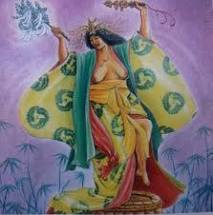Copyrighted and written by Týra Alrune Sahsnotasvriunt, 2014

Weekly Lenormand
Madame Marie Anne Lenormand (1772-1843) lived during the time of the French revolution and it is in this time of upheaval that the Lenormand cards were born. Albeit the symbols on today’s Lenormand cards were created without her input; she used regular playing cards, some of them with handwritten remarks, astrological and other symbols on them. That is why today’s Lenormand decks always include a depiction of the value of the playing cards on them. Once you have mastered learning the symbols you can easily use any card playing deck for your readings as well.
Card #5 – The Tree (7 of Hearts)
Key words:
illness, (health), medicine, long period, growth, ripening
General description:
If you are a spontaneous, impatient person you will not be pleased to see the tree anywhere near the cards answering your question. The tree card means things will take time (to evolve), a lengthy period of time even. Otherwise the tree is the medicine and illness card. If not in combination with positive cards such as the sun, the bouquet or similar it does not stand for health and advises you to take good (better) care of your physical well-being. However, the Tree in combination with the Moon – usually a positive card – means mental illness or significant emotional distress.

If you picked the Clover in for your Daily Tendency Card:
Something has been on your mind for a long time. Now is the time to explore it in depth and find the right answers for yourself.
Love
Got your eyes on someone? This is someone you might have a long and happy relationship with. (Note: long does not necessarily equal forever…!) Still, you have to be patient and tend to the seed of this little flirt in order for it to unfold its true potential. This process of ripening can’t be sped up by anything, keep the goal in mind but also enjoy every stop of the way toward it.
Work
All medical fields and related professions.
Especially when bordering on the #35 Anchor card long-lasting troubles at work are awaiting (or if combined with/surrounded by positive cards long-lasting troubles at work, such as bullying for example, are about to finally end). This card asks you to hang in there and keep on doing your best so that you will be able to reap the reward of your hard work – even if it will take a little longer (than expected…)

Health
Take extended walks in nature and meditate, quieten the mind, do breathing exercises, connect with your higher self, find your higher purpose. Allow yourself enough alone-time to fully explore your different dimensions, feel every scar, every hurt, injustice and pain and give it to the Gods to heal. Letting go of the pain does not mean you are somewhat invalidating what happened to you and that it was wrong. The tree card advises you not to let things fester. It is in most cases emotional upheaval or repressed feelings causing actual physical problems, health issues or chronic illness.
Time Factor:
Within the next few years. (Usually up to five).

Spread: Small Health Oracle
1. This is the root cause of your issues.
2. What led to your current situation.
3. What you need to do in order to change the situation for the better.
4. The most likely outcome.
5. How the situation will most likely progress if you do not initiate change.
Spread:
Pentagram-shaped: Top, top left, top right, bottom left, bottom right.














